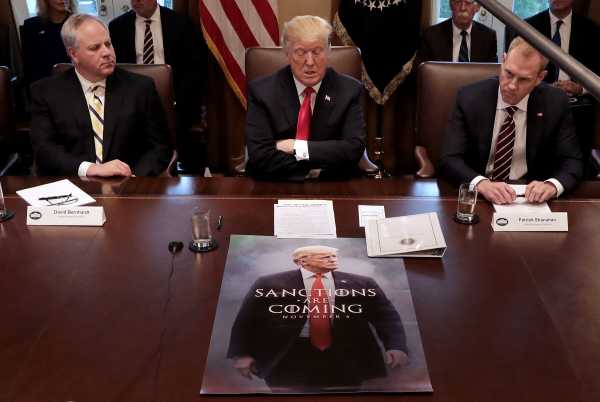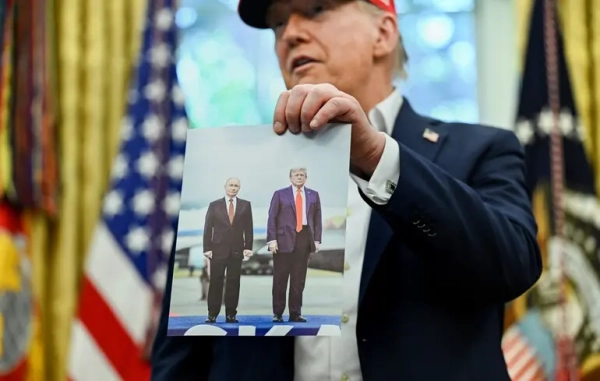
As the partial government shutdown enters its third week with little signs of progress, President Donald Trump has begun to float a new idea for building his border wall: declaring a national emergency. He could probably do it.
Trump, apparently concerned that any signs of wavering on a wall might cause some erosion of his political base, has taken his rhetoric on how he’ll get the wall to the next level in recent days as Congress appears unwilling to grant $5 billion for the construction of about 200 miles of a barrier at the US-Mexico border. Late last week and through the weekend, he has been talking about the possibility of declaring a national emergency to get the wall project done, though — in typical Trump fashion — he hasn’t been entirely clear on the details of how he sees it playing out.
“We’re looking at a national emergency because we have a national emergency. Just read the papers,” Trump told reporters on Sunday, claiming there is a “crisis at the border” of drugs, human trafficking, and crime.
When asked where the money would come from, he replied there are “a lot of different ways” but said that he wasn’t “going to get into that.”
Trump’s remarks have sparked debate about what he’s getting at, how he would do it, and whether, constitutionally, he could make such a move. Many Democrats and some legal scholars have said that Trump can’t declare a national emergency to get the border wall funded. Others say there are avenues he could definitely try, setting up potential battles in Congress and in the courts.
“He has broad leeway to declare an emergency, frankly, whether one exists or not,” said Elizabeth Goitein, a co-director of the Liberty and National Security Program at the Brennan Center for Justice, who recently wrote an in-depth explainer of presidential emergency powers in the Atlantic.
The idea of invoking emergency powers is indicative of how much discussions over the government shutdown have broken down — Trump is so hell-bent on his wall, it seems almost as if there’s no length he won’t go to in order to get it. Or at least to continue with this political stunt.
“This is really kind of Hollywood-like, what he’s trying to do,” Princeton University political historian Julian Zelizer said.
How Trump could get the wall by declaring a national emergency
Many presidents have declared national emergencies, including George W. Bush after 9/11 and Barack Obama during the swine flu outbreak.
In recent history, they’ve done so under the National Emergencies Act of 1976, which lets presidents issue an emergency declaration but under certain constraints — namely, Trump can only use specific powers Congress has already codified by law, and he has to say which powers he’s using. The 1976 law was actually passed to rein in presidential power and codify how presidents were going about declaring emergencies, from Franklin D. Roosevelt to Richard Nixon. It offers no definition for what counts as an emergency.
If Trump were to try to get border wall funding through the National Emergencies Act, the question then becomes which already-existing laws he could use to get the money. That’s where he — and the legal scholars trying to figure out what he’s talking about — run into trouble: identifying the laws and statutes he could actually use. The Brennan Center for Justice tracks about 130 laws that contain special powers Trump could access.
“It could be that by putting together a lot of different sources of emergency authority, the president could tap a lot of different funds and at least start,” Kim Lane Scheppele, a professor at the Center for Human Values at Princeton University, told me.
She pointed to a handful of preexisting laws the president could potentially use.
He could, for example, reallocate military spending on construction projects for the wall. One law allows the defense secretary, after a national emergency declaration, to direct the army’s civil works program to construct a structure needed for national defense and use the military budget to do it. Another lets the secretary direct other military services for construction projects. For example, money could come out of the budget for building housing on military bases for service members and into the budget for the wall.
Or, Trump could declare a “state of immigration emergency,” which unlocks an immigration emergency fund. It’s generally supposed to be used to help states feed and house migrants and process their claims, but Scheppele said that it is “vaguely worded enough to permit an edgy interpretation” that could get the funds for the wall. The issue there is that the fund only has about $20 million at the moment, not enough for Trump’s wall.
But if his legal team could identify enough emergency declaration laws to cobble together, they could start to gather the funds.
Some say Trump can’t do this
Since Trump started talking about declaring an emergency to fund the border wall, there has been some debate about whether he has the legal authority to do so.
Bruce Ackerman, a law professor at Yale University, wrote in an op-ed for the New York Times over the weekend that Trump cannot declare an emergency at the border, arguing that Trump’s actions would be illegal, and they would force the armed forces tasked with carrying out his orders to choose between abiding by the commander-in-chief’s wishes and committing a federal crime.
“The president of the United States has a constitutional duty to take care that the laws be faithfully executed,” Ackerman said in a subsequent phone interview. “It is unconstitutional for him to take care to violate the laws of the United States.”
He called Trump’s threat a “profound crisis.”
Others have echoed Ackerman’s declaration that Trump can’t lawfully declare a state of emergency for the wall.
Rep. Adam Schiff (D-CA) in an appearance on CNN’s State of the Union Sunday said the idea was a “non-starter.” Fox News judicial analyst Andrew Napolitano said in a Fox Business appearance on Monday that the president “cannot spend money unless it’s been authorized by Congress.”
Some have pointed to a Korean War-era court case, Youngstown Sheet & Tube Co. v. Sawyer, in which the Supreme Court ruled that President Harry Truman’s attempt to nationalize US steel mills during a strike during the Korean War was unconstitutional. “If Harry Truman couldn’t nationalize the steel industry during wartime, this president doesn’t have the power to declare an emergency and build a multibillion-dollar wall on the border,” Schiff told CNN.
Scheppele, however, expressed skepticism that case actually applies in what Trump is proposing to do. “Once you get into the specific area of emergency powers, then the president is acting within a delegated framework,” she said.
Others say Trump can do it — and it might be harder to stop him than you’d think
If Trump does declare a national emergency for the border wall, there will almost certainly be challenges to him in both Congress and the courts. But it’s not entirely obvious they will stick. As we saw with Trump’s travel ban, he’s often willing to do things that go over the legal line, then leave the courts to figure out where exactly that line lies.
The National Emergencies Act contains a mechanism for Congress to overrule the president by passing a joint resolution out of the House and Senate. With Democrats in control of the House, it would presumably pass there easily, and Ackerman, the Yale professor, says he believes it could pass the Senate, too.
“Mitch McConnell does not have the power to bottle this up,” he said. “So that means that there would be a moment of truth for the Republican Party.”
But thanks to a 35-year-old court case, Congress might not be able to override the president that easily. In the 1983 case Immigration and Naturalization Service v. Chadha, the Supreme Court decided that a one-house legislative veto violated the Constitution. After that, the National Emergencies Act was amended to require the joint resolution to override the president’s declaration — like a typical law, it requires a simple majority in the House and Senate and the president’s signature.
Trump would probably not be willing to sign a joint resolution to reject his own emergency declaration, so that means that Congress would need to override him with a two-thirds majority in each chamber.
“The safeguard you think is there in the National Emergencies Act turns out not to be there, or at least most constitutional scholars who have looked at that question closely think that the Supreme Court would never go for it, especially now that we have a Supreme Court with two new members who are unusually deferential to executive power,” Scheppele said. “It could be that actually nobody could tell him no.”
A national emergency declaration for the border wall would likely face a challenge in the courts. But it’s not clear which parties would have standing to file a lawsuit, and moreover, any decisions would take time.
Being the first mover in declaring the emergency would give Trump a “tremendous advantage,” Ackerman said.
“There are good legal challenges, to be sure, and I think there would be a real fight,” Goitein, from the Brennan Center, said.
The thing is, there is no emergency
Beyond the legal questions around what Trump can do and how he can do it, there are some more fundamental issues: The United States government is shut down over a campaign trail call that Trump uses to rile up his base, and there’s no new emergency at the US-Mexico border.
“There is no national security crisis,” Zelizer, from Princeton, said. “We are not at war, and it’s not clear anything is happening at the border.”
This isn’t the first time Trump has invented an immigration crisis when convenient — ahead of the midterms, he started warning about dire threats from a migrant caravan, only to more or less drop the issue once November 6 came and went. Now that Congress won’t agree to his border wall, and obviously Mexico isn’t paying for it, he’s manufacturing panic yet again.
“There’s an emergency whenever it suits his purposes, but that ought not be the test,” said Michael Gerhardt, a constitutional scholar at the University of North Carolina’s School of Law.
This also puts to the test the Republican Party and its willingness — or, frankly, lack thereof — to stand up to him. The GOP spent years complaining about Obama’s overreach, so now that Trump’s making up an emergency to pay for a border wall Congress does not want, what will they do?
“If this were a Democratic president, Republicans would say Obama is going to have to put up or shut up. But because it’s Trump, Republicans will argue that we should defer to the president,” Gerhardt said. “We have to consider at what point this deferral means the president is usurping legislative authority.”
It’s not yet clear whether Trump actually plans to declare an emergency, or if this is yet another case of him making empty threats. Vice President Mike Pence said on Monday that the White House counsel was looking at the legality of it and hadn’t yet made a decision. But it appears as though he could certainly try.
“It’s certainly not a slam dunk that he can,” Goitein said, “but it’s not a slam dunk that he can’t, either.”
Sourse: vox.com






